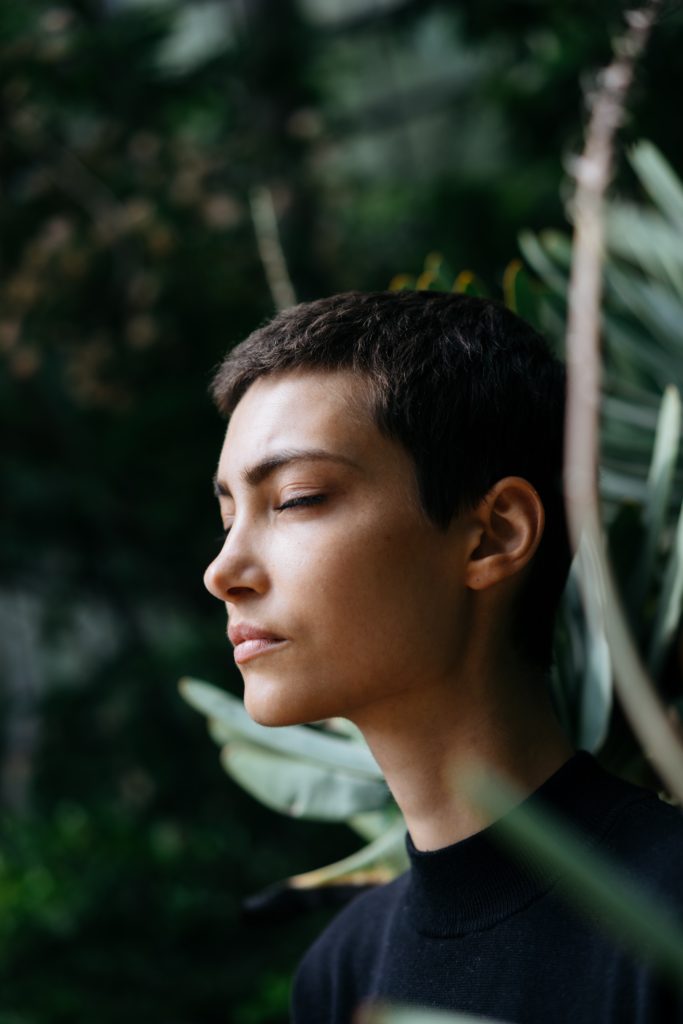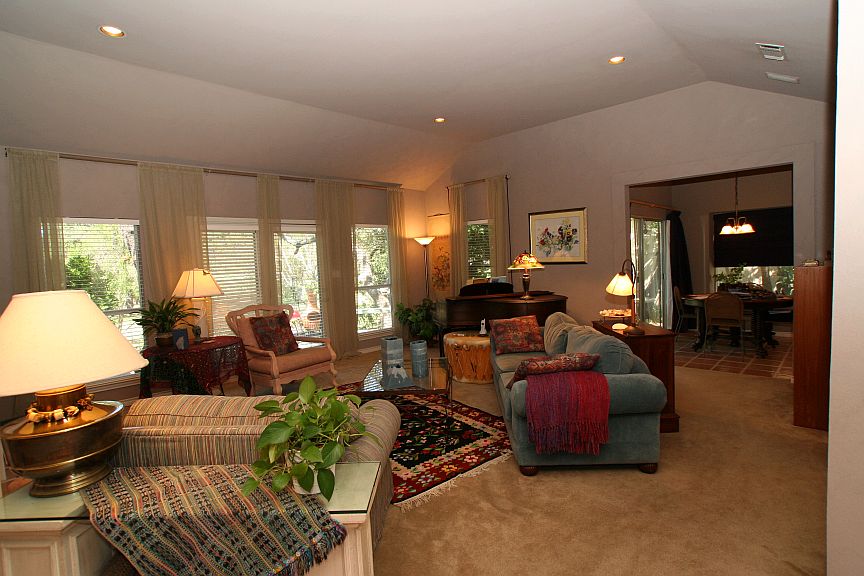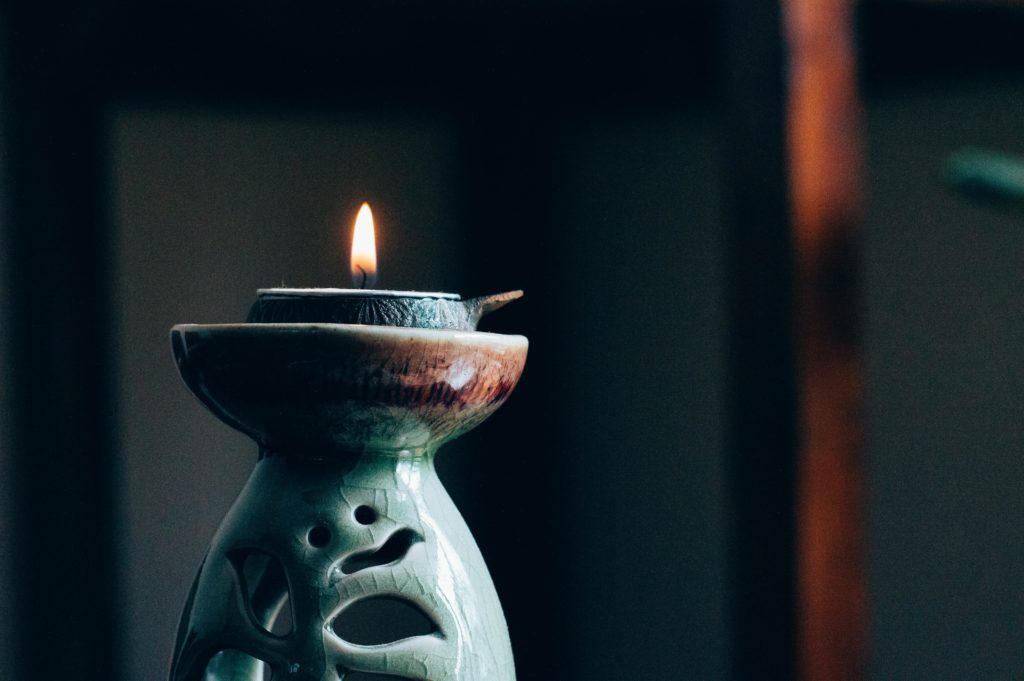by Nancy Wesson
Reprinted from The Austin Homesteader, 2003
We are living in some strange times. The universe-is-tilting, there’s Code Orange, Code Pink, Peace Vigils, Anti-War Marches, hormones in the meat and fake corn, Cloning…. What’s a body to do? Makes you want to retreat a nice cave and hibernate ‘till all this passes. But a good cave is hard to find, and with the price of utilities and oil – could you afford to heat I? Alas, we are not bears or bats and hibernation is not an option. So what are we to do to restore peace of mind and find a bit of tranquility in our lives.

I just finished writing some text for a beautiful image entitled Tranquility on my Web Site. It occurred to me that we could all use a dose of that right about now and since Feng Shui offers an approach to guide us there, I’ll share some ideas with you along with a technique to help you relax any time, any where.
Making Home Your Retreat
In the absence of a good cave to go to, why not makes our homes our retreat – our sanctuary. I know – most of us think of a retreat as a place away from home, some cushy resort where every need is taken care of or a nice little bungalow on the top of a mountain or nestled by the shore. But what could be better than having a place we can go to every day, without spending massive amounts of money to get to. And no, you don’t have to remodel or re-decorate your home to achieve the retreat-feel either. Clear out some clutter, light some candles, and Ommmmm. Well, it’s not quite that simple!
Get Centered

First of all, tranquility is a by-product of perception and inner calm. We can’t always change the world around us a quickly as we’d like, but we can shift the way we perceive or think about things. And we can control our own immediate sphere. So look around, find a comfy place to sit and think about what it is that helps you feel safe, centered and calm. You may find that some ingredients are physical, some relate to the senses, and others are more mystical. It’s helpful to use elements of each because you can’t always plop down in your favorite chair, but you may be able to close your eyes, take a breath and repeat a mantra – which is really nothing more than a sound or phrase you can return to when your mind wanders in directions you’d prefer it not go
Move Your Stuff
Let’s talk about the physical first – partly because nothing is so immediate as the shift that comes from moving your belongings. I’ve had clients gasp in excitement and weep with joy after their living rooms suddenly became the place they dreamed of. Nothing new was added, we just shifted things around and used others in a different way. A space that five minutes ago felt alien and unwelcoming, suddenly feels like home, because each of us has an internal compass that knows when it feels “home.” Here are some ideas.
- Arrange your living room or family room seating in an “open arms” configuration, so that you feel like you’re being embraced when you walk into the room. Couches with backs to the main entrance feel unfriendly and deter people from gathering in the space.
- Couches or chairs placed directly opposite from each other create mode oppositional interactions, while U-shaped or L-shaped arrangements promote conversation and consensus, resulting in our feeling calmer in the room.
- In your bedroom or study, have a nice reading chair with a light on one side and a table on the other. You’ll find you gravitate toward that spot to meditate, ponder, read and relax. The light should be easy to turn on at arms length, and the table is to put a nice cup of hot tea or icy lemonade on. Remember, everything within easy reach. You’re relaxing…
- If your rooms are big and/or your furniture is spread way apart or lined up against the walls, pulling it into a closer conversational distance can help you feel more connected in general. Simultaneously, it also encourages real conversation and feels safer. A good by-product is that the room usually ends up feeling bigger – contrary to logic.

If your rooms are big and/or your furniture is spread way apart or lined up against the walls, pulling it into a closer conversational distance can help you feel more connected in general. Simultaneously, it also encourages real conversation and feels safer. A good by-product is that the room usually ends up feeling bigger – contrary to logic.
The Basic Five Senses
On the sensory level tremendous emotional comfort results internally from the appropriate use of our five senses. Why do you think Realtors adjust the lighting and bake chocolate chip cookies or bread before a prospective buyer comes in?
- Sight: Lighting is a big deal. Overhead lighting, while sufficient in some cases, does not particularly promote a sense of well-being. Does your home or office feel like an interrogation room? Replace those lights (or get some rose tinted lenses)! Task or mood lighting can change your mood in a blink. Try full-spectrum or soft-lighting bulbs for starters.
- Taste: Both the fragrance and taste of a cup of tea can pop you right into another another level. Chamomile calms jangled nerves and for some just the smell of a cup of coffee feels welcoming.
- Sound: A water feature can shift your mood when you enter the room. Listen to it before you bring it home. Not all fountains are created equal. Similarly, replacing the insanity of TV news with your favorite music can de-escalate the fear and stress created by the daily chaos.
- Touch: Textures make a difference in how we feel as well. This depends on preference, so take a “feel” trip and find out what works for you. Is it velvet, silk, or nubby? What ever it is, having it around you makes you feel well-taken-care-of.
- Smell: While Potpourri is not for me (dead stuff), essential oils can be used to create a a specific ambience.

Lavender and rose are known for their ability to reduce stress, while rosemary can act as a stimulant. Essential oils are available everywhere these days, but a little goes a long way. Make sure that what passes your sniff test doesn’t antagonize someone else in the house.
Your Sixth Sense
No, not the movie! And no, Bruce Willis does not come with it…sorry. Intuition – we all have it. Use it to guide you to what brings you comfort and what’s not working. But here, I’m also talking about your inner world – the one less tangible, and probably the most important when we’re talking peace-of-mind.
Who was it who said, “Perception is nine-tenths of reality?” Well, it’s true. An entire room full of people witness an event, yet each has a slightly different take as to what “really happened.” Emotions, past history, point-of-view, innate optimism or pessimism all influence how we view and process “reality.” Given any particular set of circumstances, we have a choice about how we view them, use them, respond to them. Even in the present circumstances of uncertainty, there is opportunity for us to embrace the challenge of deciding how we will respond in our thought, actions and hearts. It’s absolutely personal, but DECIDE – don’t just respond.
“Sitting”
Consider taking some time to climb off the roller-coaster and be still using this proven technique that works to adjust body chemistry, blood pressure, heart rate and anxiety. It can also boost intuition and give you a sense of inner tranquility in the midst of chaos. Just don’t close your eyes if you’re driving! It’s called the Relaxation Response (adapted from the book: The Relaxation Response by Herbert Benson, M.D.) I use it successfully in my Intuition Development Classes, and have taught it to Diabetes Support groups learning how to manage their own body chemistry and stress. Try it every day for 15 minutes, starting with just 5 minutes if you need to tip-toe into it. I call it “sitting” to stay away from the term meditation, which conjures up judgments about whether you’re doing it “right.”

Essential Elements:
- A quiet environment
- Comfortable position
- A mental device (phrase, sound, candle flame)
- Non-judgmental attitude
The “Sitting” Technique
- Sit quietly
- Close your eyes
- Relax all muscles, starting with your feet and move upward to your facial muscles. Remain relaxed.
- Breathe in through your nose, exhale via the mouth and be aware of your breathing.
- Continue sitting in this way for 15 – 20 min. Use your mental device to help keep focused if your mind wanders or fixates on a thought.
- Keep an open attitude. DON’T JUDGE yourself. Allow feelings, sensations, and thoughts to emerge. Be an observer.
Tranquility
Although tranquility results from a combination of conditions, both external and internal, individual needs can vary. For example, one person may need space and minimalist décor, while another might prefer being surrounded by rich colors and sumptuous fabrics, and yet another needs a woodsy, natural theme to feel at peace. Tolerating surroundings that are contrary to who you are can make you feel out-of-place, anxious and frustrated – draining your energy. Taking time out to “sit” and enveloping yourself with materials that calm and relax the senses help create the sacred space you need to feel at peace with the world.
Peace can be found in environments that speak to who you are and guide you toward who you want to become. Tune up your office or make your home your retreat. Every time you walk in you’ll feel the relief envelop you. Relax, breathe and recharge. Peace of mind is just a breath away.
